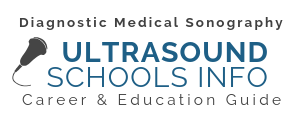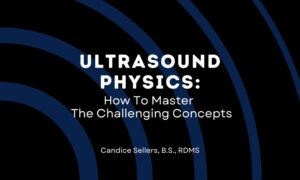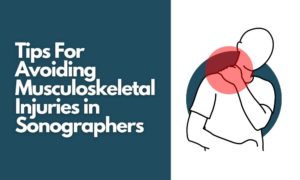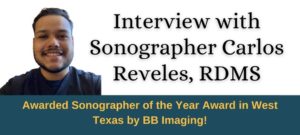It’s common for sonographers and ultrasound technicians to experience work-related pain or to develop musculoskeletal injuries. Affected areas can include the neck, shoulders, elbows, wrists, hands and the upper and lower back. Disorders can range from temporary injury to having to give up work due to the development of a permanent disability.
Consider these statistics:
- Work related musculoskeletal disorders (WRMSDs) affect up to 90% of diagnostic medical sonographers (SDMS).
- Of those sonographers experiencing pain, 20% had career-ending injuries.
- About 9/10 of sonographers report they have neck, shoulder and/or back pain or issues which “prevent them from doing their job at the optimal level” (Wuebben & Roozen, 2015).
Ergonomics (such as the design and layout of ultrasound equipment and the exam room) and a healthy posture are two factors that can help prevent musculoskeletal injuries and disorders. So can regular stretching.
Sonographers, Get Ready to Stretch
As regular stretching is a great way for sonographers to keep their bodies from sustaining serious injuries, we’ve compiled some examples of helpful stretches to perform several times of day. This daily practice, along with these tips to avoid injury, can help promote a long and healthy career.
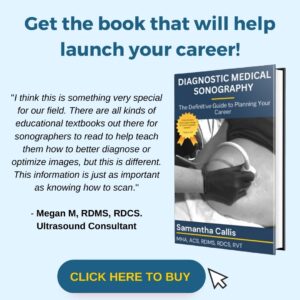 They have been gleaned from two sets of experts/resources: The first is Michael Cursaro, B.MedSc, DMU, and his colleagues from the Cardiac Diagnostic Suite at the Royal Adelaide Hospital, who, in consultation with physiotherapy and occupational therapy professionals developed a daily stretching routine especially for sonographers. The second is several Aunt Minnie articles by registered echocardiographer and ergonomics author, Doug Wuebben, and also certified strength and conditioning specialist, Mark Roozen.
They have been gleaned from two sets of experts/resources: The first is Michael Cursaro, B.MedSc, DMU, and his colleagues from the Cardiac Diagnostic Suite at the Royal Adelaide Hospital, who, in consultation with physiotherapy and occupational therapy professionals developed a daily stretching routine especially for sonographers. The second is several Aunt Minnie articles by registered echocardiographer and ergonomics author, Doug Wuebben, and also certified strength and conditioning specialist, Mark Roozen.
Wrist Stretch
Hold your right arm straight out with your elbow facing down. Hold your right hand’s fingers with your left hand and pull them towards you for 15 seconds. Switch sides. (This also stretches your forearms).
Neck Tilt
While standing with straight posture, lean your neck to the right as if your ear is leaning towards your shoulder (don’t make them actually touch). Hold that for 15 seconds and then switch sides.
Ankle Grab
Sit straight on the edge of a chair. Bend over with head facing down and grab your ankles. Aim for your head to reach your knees. Breathe in and out deeply (breathe in for five counts and out for five counts). Stay in this position for about six to eight breaths. This is a great stretch to promote deep breathing and to help relieve tightness in your neck and shoulders.
Upper Back Stretch
Extend your arms in front of you and turn your wrists so you can interlock your fingers. (When your fingers are interlocked, your palms should be facing out). Stretch your shoulders and arms outward and hold for 15 seconds.
Reach for the Sky
While standing or sitting straight, extend your arms so they are reaching up towards the ceiling on either side of your head. Your palms should be facing inwards, and as you are reaching your arms up, push your shoulders back. Wuebben describes it as “think of pinching a pencil between your shoulder blades.” Take some deep inhales and exhales while reaching as high as you can. This stretch is also great for breathing, the neck and shoulders.
Shoulder Rolls
Roll your shoulders backwards ten times while you’re standing with arms to your sides. Repeat, rolling shoulders forwards.
Squat to Reach
Stand with knees slightly bent and feet flat to the floor. Bend down to touch your toes. Then wrap your hands around your ankles and bend into a squat. While remaining in a deep squat position, raise one arm and then the other towards the ceiling. Keeping your arms straight up, stand up. This is an example of a stretch which can help improve hip mobility; and according to Wuebben and Roozen (2016), improving hip mobility helps eliminate back pain.
Kneeling Lunge
Kneel on one knee with its lower leg lying flat behind. Plant the other foot flat on the ground in front so its leg is folded at a 90 degree angle. Once you’re steady in this position, lean your hips and torso forward gently for a deeper stretch. For an even deeper stretch, raise your arms above your head. Switch sides. This stretch is also good for hip mobility.
And finally…Walk!
In addition to these stretches, it’s beneficial to try and walk around for 5 minutes every hour. Walk down the hall and back, up and down a flight of stairs or two, or even a couple of laps around your office will loose muscles and joints that tend to stiffen while sitting or scanning.
References
Cursaro, Michael, B.MedSc, DMU, Cardiac Diagnostic Suite, Royal Adelaide Hospital, et al. “Ergonomics – Taking Care of Yourself” (Sonographers’ Communication). Journal of the American Society of Echocardiography. March 2014: 36A-37A.
Rousseau, Thierry, MD, et al. “Practice Guidelines for Prevention of Musculoskeletal Disorders in Obstetric Sonography.”Journal of Ultrasound in Medicine. 1 Jan. 2013.
Wuebben, Doug. “Making a Difference as a Sonographer: Pain in the neck.” AuntMinnie.com. 8 Sept. 2015.
Wuebben, Doug; Roozen, Mark. “Living Pain-Free: Sonographer back pain, part 1.” AuntMinnie.com. 12 Nov. 2015.
Wuebben, Doug; Roozen, Mark. “Living Pain-Free: Sonographer back pain, part 4.” AuntMinnie.com. 21 Jan. 2016. Web. Accessed 10 Feb. 2016.
